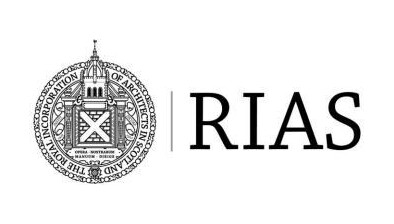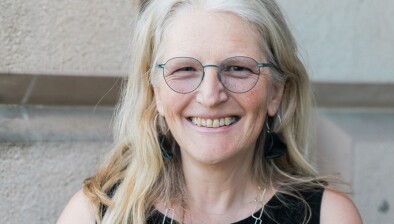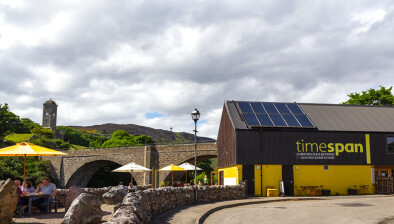Nicholas Groves-Raines honoured with RIAS Lifetime Achievement award

Nicholas Groves-Raines FRIAS with wife, Kristin Hannesdottir (c) Malcolm Cochrane
Edinburgh architect Nicholas Groves-Raines has been presented with the Lifetime Achievement Award of the Royal Incorporation of Architects in Scotland (RIAS) for his outstanding contribution to architecture in Scotland.
The award was presented by RIAS President, Stewart Henderson, during the annual RIAS Awards Dinner in Edinburgh on Wednesday night.
Mr Henderson said: “This Award recognises those whose life-long endeavour marks them out from their peers. This year’s winner exemplifies a crucially important strand of architectural endeavour, too often undersung or overlooked. Nick Groves-Raines has spent a lifetime rescuing, restoring and ensuring a viable future for some of our finest historic buildings. His practice has undertaken numerous award-winning new-build and restoration projects - achieving excellence in all they do.”
The citation for Nicholas Groves-Raines was read out at the event:
Nicholas Groves-Raines, affectionately known as Nick, is Managing Director of Groves-Raines Architects Ltd based in Lambs House, Leith. RIAS Conservation Accredited at the advanced level, he has over 40 years’ experience on an extraordinary variety of conservation and development projects.
That very brief outline, while acknowledging Nick’s expertise and his distinguished career, does not reflect the remarkable contribution of Nick Groves-Raines and indeed of his wife, Kristin Hannesdottir (known affectionately as Limma) and his family, to the care and conservation of the architectural heritage of Scotland and well beyond.
Nicholas Robert Pellew Groves-Raines was born in May 1940 in Bangor Hospital, Northern Ireland, the second son of an army father. His dad’s peripatetic career saw Nick attending 15 different schools in Northern Ireland, England, Hamburg and even Malaysia. He was very good at drawing and on account of his having a great aunt in Edinburgh, signed up to study architecture at the College of Art. He never completed the course and subsequently took the qualifying exams externally.
Throughout his long career, Nick Groves-Raines has combined architectural practice with the personal endeavour of buying, saving, restoring and re-using many important historic buildings. His long list of credits testifies to his personal passion for historic buildings, a profound belief in their importance as touchstones of our shared history and extraordinary personal commitment, engagement, doggedness and energetic enthusiasm.
Nick’s Icelandic architect wife, Limma, has been hugely helpful in providing the information for this citation. In Limma’s, characteristically frank, own words she talks about a lifetime of running alongside Nick’s latest historic building cause “usually quite happily, but occasionally with poor grace, little or no money but an optimism, on occasion bordering on stupidity”. Strangely that optimism has almost invariably paid off.
I will come back to the architectural practice, but firstly a quick synopsis of Nick’s career as a saviour of historic buildings for himself or through the various incarnations of his practice’s development arm, well-known by many by its former name, Steinhus Ltd. In 1969 Nick purchased a traditional bothy on a deserted island in County Donegal for £600. That home, subsequently restored, still serves as a family holiday house.
Three years later he purchased the two upper floors of Mowbray House, one of the oldest inhabited houses in Edinburgh. He saw beyond the flush panel doors, washable wallpaper and plate glass windows. The restoration of the building revealed a vaulted, painted ceiling, the reinstatement of the historic room arrangement, installation of reclaimed 17th Century doors, a rebuilt gable, appropriately horizontal glazing and timber cladding.
1974 saw the purchase of derelict buildings in two courtyards at Old Tolbooth Wynd, Gladstone Court, off the High Street from Edinburgh Council who didn’t know they owned it. The pigeons were evicted, the building restored and Nick moved his practice in. Lees Stables, Coldstream, was purchased for £500, pigeons and rats evicted, the building restored then sold on.
In 1980 the derelict 1636 tower house in Craigmillar, Peffermill House, was purchased for £5,000. The building had been let to a scrap merchant and stripped bare. Nick’s legal advisors warned that the purchase was madness and that moving there would be an act of lunacy. Nick restored the building and moved not only his office, but his family in. The Peffermill Christmas parties of the 1980s are legend.
Further Edinburgh buildings, including Robertson’s Close and the Craigwell Brewery, were acquired and converted to housing during the 1980s. In 1985, on the hunt for a cottage, Nick and Kristin instead bought a 16th Century cursed and haunted fortified house on Loch Erne. True to form, Edinample Castle was rigorously restored, much of it through personal hands-on effort with the family staying every weekend on-site in a tin shed.
The late 80s and early 90s saw a series of purchases in the west, including at Speirs Wharf, Glasgow, subsequently sold on for development, Annanhill House, Kilmarnock, the 1848 David Bryce Tollcross Mansion in Glasgow and a tenement block at James Morrison Street in Glasgow’s East End.
In 1997, the burnt out Liberton House was acquired, restored and became home to the Groves-Raines family and the practice office. The latest such endeavour is, of course, Lambs House in Leith, acquired in 2010 in a very sorry state. Superbly restored, the building now houses the family and a practice which currently employs 30 people with Nick’s son, Gunnar, as a co-director.
It seems remarkable, considering Nick’s achievements in the fields of restoration and development, that he also had the time to build a very highly regarded architectural practice. Over the years the practice has welcomed architects of many nationalities through its doors and nurtured and supported the careers of some of the most highly regarded of Scotland’s contemporary architects. Nick has mentored the likes of Stephen Bell, Alison Blamyre, Andy Bow (now a Director with Fosters), the late Andy Doolan, Richard Erdal, John Forbes, Malcolm Fraser, the late Rob Hunter, Alex Kettles, Henry McKeown and Allan Murray.
Nick originally set up in practice with the late Edwin Johnson and Alec Brown in Broughton Market, Edinburgh. Nicholas Groves-Raines Architects was subsequently established with Limma as a partner.
Over time, important commissions have included the Stirling Castle Landmark building, the Traverse Theatre, Edinburgh, St Andrews in the Square undercroft in Glasgow, Strathleven House, in Dumbartonshire, Sumburgh Head Lighthouse, numerous castles and fortified houses. Belmont House, Unst, Shetland, the northernmost classical house in Britain, was like many of these projects, multiple award-winning, as was Edinburgh’s Eric Liddle Centre.
Other projects have included Lerwick Town Hall, Castle Hume, the Cottier Theatre and Landsdowne churches in Glasgow, Lissan House, County Tyrone, Goblusk House, a new Palladian villa and Hays Dock, part of Shetland Museum. A modest garden composting shed in Edinburgh achieved the extraordinary recognition against huge international competition of a Gold Medal from the American Institute of Architects.
A further strand to Nick’s remarkable life in architecture is, of course, his longstanding business partnership with his wife. She describes their meeting in the early 70s. He was like no-one she had ever known.
He had just built an egg-yolk yellow beach buggy with a Porsche engine, he cut his own hair and even made some of his own clothes. From then on, family life with their three children, Sigrun, Haddla and Gunnar and more recently five grandchildren, has been inextricably woven into the complex weave of the wider family of the practice and their shared endeavour of architecture and historic buildings.
Nick’s contribution to public life too is impressive. A former Trustee of the National Trust for Scotland, he currently sits on the board of the Queen’s Hall, Edinburgh, served on the executive of the Friends of Water of Leith, currently advises the Leith Theatre Trust and the SS Explorer Preservation Society and has been the main driver behind the current regeneration and re-use of the Custom House in Leith. He also serves on the steering group for Sculpture by the Sea.
Nicholas Groves-Raines is a man whose achievements would take most ordinary mortals several lifetimes. He and Kristin are among the best known and best loved double-acts in Scottish architecture. Andy Bow has commented that his period working with them at Peffermill was a “glorious time in a really, really happy place”. Like all of those who have worked with the practice, he comments on feeling like part of Nick and Limma’s extended family amid a remarkably creative atmosphere, constantly lively and, on occasion, just a little chaotic.
Kate, the ever friendly golden labrador, running around being everybody’s friend, then Molly the Irish setter who would rest her head in the lap of job interviewees in the Groves-Raines kitchen. Whilst that wasn’t a deliberate test, Molly undoubtedly helped in determining who was suitable.
All of those who have touched upon or have been part of the Groves-Raines practice have only good things to say. As one distinguished former employee put it, Nick and Limma would do anything for you. And Nick was ever the consummate professional - not just a lifelong passionate restorer of great buildings, the creator of great buildings too.













